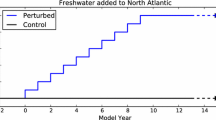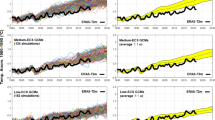Abstract
The Atlantic multidecadal variability (AMV) is a coherent pattern of variability of the North Atlantic sea surface temperature field affecting several components of the climate system in the Atlantic region and the surrounding areas. The relatively short observational record severely limits our understanding of the physical mechanisms leading to the AMV. The present study shows that the spatial and temporal characteristics of the AMV, as assessed from the historical records, should also be considered as highly uncertain. Using 11 multi-century preindustrial climate simulations from the Coupled Model Intercomparison Project Phase 5 (CMIP5) database, we show that the AMV characteristics are not constant along the simulation when assessed from different 200-year-long periods to match the observed period length. An objective method is proposed to test whether the variations of the AMV characteristics are consistent with stochastic internal variability. For 7 out of the 11 models analysed, the results indicate a non-stationary behaviour for the AMV time series. However, the possibility that the non-stationarity arises from sampling errors can be excluded with high confidence only for one of the 7 models. Therefore, longer time series are needed to robustly assess the AMV characteristics. In addition to any changes imposed to the AMV by external forcings, the detected dependence on the time interval identified in most models suggests that the character of the observed AMV may undergo significant changes in the future.








Similar content being viewed by others
References
Ba J, Keenlyside NS, Latif M, Park W, Ding H, Lohmann K et al (2014) A multi-model comparison of Atlantic multidecadal variability. Clim Dyn 43(9–10):2333–2348
Bellucci A, Mariotti A, Gualdi S (2017) The role of forcings in the 20th century North Atlantic multi-decadal variability: the 1940–1975 North Atlantic cooling case study. J Clim 30:7317–7337
Booth BBB, Dunstone NJ, Halloran PR, Andrews T, Bellouin N (2012) Aerosols implicated as a prime driver of twentieth-century North Atlantic climate variability. Nature 484:228–232
Brockwell PJ, Davis RA (1991) Time series: theory and methods. Springer, New York
DelSole T, Tippett MK, Shukla J (2011) A significant component of unforced multidecadal variability in the recent acceleration of global warming. J Clim 24:909–926
Delworth TL, Mann ME (2000) Observed and simulated multidecadal variability in the Northern Hemisphere. Clim Dyn 16:661–676
Deser C, Blackmon ML (1993) Surface climate variations over the North Atlantic Ocean during winter: 1900–1989. J Clim 6:1743–1753
Deshayes J, Curry R, Msadek R (2014) CMIP5 model intercomparison of freshwater budget and circulation in the North Atlantic. J Clim 27:3298–3317
Ebisuzaki W (1997) A method to estimate the statistical significance of a correlation when the data are serially correlated. J Clim 10:2147–2153
Enfield DB, Mestas-Nuñez AM, Trimble PJ (2001) The Atlantic multidecadal oscillation and its relation to rainfall and river flows in the continental US. Geophys Res Lett 28(10):2077–2080
Frankcombe LM, von der Heydt A, Dijkstra HA (2010) North Atlantic multidecadal climate variability: an investigation of dominant time scales and processes. J Clim 23(13):3626–3638
Goldenberg SB, Landsea CW, Mestas-Nuñez AM, Gray WM (2001) The recent increase in atlantic hurricane activity: causes and implications. Science 293:474
Gray ST, Graumlich LJ, Betancourtv JL, Pederson GT (2004) A tree-ring based reconstruction of the Atlantic Multidecadal Oscillation since 1567 A.D. Geophys Res Lett 31:L12205
Hasselmann K (1976) Stochastic climate models, Part I. Theory. Tellus 28:473–485
Huang J, Higuchi K, Shabbar A (1998) The relationship between the North Atlantic oscillation and El Niño-Southern oscillation. Geophys Res Lett 25:2707–2710
Hurrell JW, Van Loon H (1997) Decadal variations in climate associated with the North Atlantic oscillation. Clim Change 36:301–326
Kilbourne KH, Alexander MA, Nye JA (2014) A low latitude paleoclimate perspective on Atlantic multidecadal variability. J Mar Syst 133:4–13
Knight JR, Allan RJ, Folland CK, Vellinga M, Mann ME (2005) A signature of persistent natural thermohaline circulation cycles in observed climate. Geophys Res Lett 32:L20708
Knight JR, Folland CK, Scaife AA (2006) Climate impacts of the Atlantic multidecadal oscillation. Geophys Res Lett 33:L17706
Kushnir Y (1994) Interdecadal variations in North Atlantic Sea surface temperature and associated atmospheric conditions. J Clim 7:141–157
Latif M, Collins M, Pohlmann H, Keenlyside NS (2006) A review of predictability studies of Atlantic sector climate on decadal time scales. J Clim 19:5971–5987
Latif M, Keenlyside NS (2011) A perspective on decadal climate variability and predictability. Deep Sea Res. Part II 58(17–18):1880–1894
Mariotti A, Dell’Aquila A (2012) Decadal climate variability in the Mediterranean region: roles of large-scale forcings and regional processes. Clim Dyn 38:1129–1145
Marullo S, Artale V, Santoleri R (2011) The SST multidecadal variability in the Atlantic–Mediterranean region and its relation to AMO. J Clim 24:4385–4401
Medhaug I, Furevik T (2011) North Atlantic 20th century multidecadal variability in coupled climate models: sea surface temperature and ocean overturning circulation. Ocean Sci 7:389–404
Menary MB, Hodson DLR, Robson JI, Sutton RT, Wood RA, Hunt JA (2015) Exploring the impact of CMIP5 model biases on the simulation of North Atlantic decadal variability. Geophys Res Lett 42:5926–5934
Otterå OH, Bentsen M, Drange H, Suo L (2010) External forcing as a metronome for Atlantic multidecadal variability. Nat Geosci 3:688–694
Rayner NA, Parker DE, Horton EB, Folland CK, Alexander LV, Rowell DP, Kent EC, Kaplan A (2003) Global analyses of sea surface temperature, sea ice, and night marine air temperature since the late nineteenth century. J Geophys Res 108:4407
Rotstayn LD, Lohmann U (2002) Tropical rainfall trends and the indirect aerosol effect. J Clim 15:2103–2116
Saenger C, Cohen AL, Oppo DW, Halley RB, Carilli JE (2009) Surface-temperature trends and variability in the low-latitude North Atlantic since 1552. Nat Geosci 2:492–495
Schlesinger ME, Ramankutty N (1994) An oscillation in the global climate system of period 65–70 years. Nature 367:723–726
Sutton RT, Dong B (2012) Atlantic Ocean influence on a shift in European climate in the 1990s. Nat Geosci 5:788–792
Sutton RT, Hodson DLR (2005) Atlantic Ocean forcing of North American and European summer climate. Science 309:115
Swingedouw D, Mignot J, Labetoulle S, Gilardi E, Madec G (2013) Initialisation and predictability of the AMOC over the last 50 years in a climate model. Clim Dyn 40:23981–23990
Taylor KE, Stouffer RJ, Meehl GA (2012) An overview of CMIP5 and the experiment design. Bull Am Meteorol Soc 93:485–498
Terray L (2012) Evidence for multiple drivers of North Atlantic multi-decadal climate variability. Geophys Res Lett 39:L19712
Thomson DJ (1982) Spectrum estimation and harmonic analysis. Proc IEEE 70(9):1055–1096
Ting M, Kushnir Y, Seager R, Li C (2009) Forced and internal twentieth-century SST trends in the North Atlantic. J Clim 22:1469–1481
Ting M, Kushnir Y, Seager R, Li C (2011) Robust features of Atlantic multi-decadal variability and its climate impacts. Geophys Res Lett 38:L17705
Ting M, Kushnir Y, Li C (2014) North Atlantic multidecadal SST oscillation: external forcing versus internal variability. J Mar Syst 133:27–38
Trenberth KE, Shea DJ (2006) Atlantic hurricanes and natural variability in 2005. Geophys Res Lett 33:L12704
Wittenberg AT (2009) Are historical records sufficient to constrain ENSO simulations? Geophys Res Lett 36:L12702
Zanchettin D, Rubino A, Jungclaus JH (2010) Intermittent multidecadal-to-centennial fluctuations dominate global temperature evolution over the last millennium. Geophys Res Lett 37:L14702
Zanchettin D, Bothe O, Müller W, Bader J, Jungclaus JH (2014) Different flavors of the Atlantic multidecadal variability. Clim Dyn 42(1–2):381–399
Zhang R (2008) Coherent surface-subsurface fingerprint of the Atlantic meridional overturning circulation. Geophys Res Lett 35:L20705
Zhang R, Delworth TL (2006) Impact of Atlantic multidecadal oscillations on India/Sahel rainfall and Atlantic hurricanes. Geophys Res Lett 33:L17712
Zhang L, Wang C (2013) Multidecadal North Atlantic sea surface temperature and Atlantic meridional overturning circulation variability in CMIP5 historical simulations. J Geophys Res Oceans 118(10):5772–5791
Author information
Authors and Affiliations
Corresponding author
Appendix
Appendix
1.1 A detailed explanation of the method for testing AMV stationarity
A detailed explanation of the method for testing AMV stationarity is given here using the MPI-ESM-P model example. The starting point is the generation of 1000 synthetic time series with the same length and the same spectrum as the model NASST time series (1156 years for the MPI-ESM-P model). In Fig. 9, the 1000 synthetic time series, in green, share the same spectrum (top plot) and autocorrelation (bottom plot) as the model time series (superimposed as a thick black line). Having verified this, it is possible to compute the 90% central range for the autocovariance function that represents the 90% range of variation of autocovariance values for each lag. Each of the 1000 synthetic AMV time series is split in 200-year-long intervals shifted by 1 year, obtaining 956(= 1156 − 200) intervals for MPI-ESM-P model. Therefore, there are 956,000 intervals for all the 1000 synthetic time series. The autocovariance function is computed for all these intervals, spanning 60 lags. For each lag, the 90% central range (i.e. the range between the 5th percentile and the 95th percentile) of the 956,000 autocovariance values is computed.
In parallel, also the model AMV time series is divided in 956 intervals and the autocovariance is computed for all of them. For each lag, the 956 autocovariance values are compared with the inferior and superior limits of the 90% central range and we count how many values exceed the range.
In order to have a reasonable number of intervals to be shown together, in Fig. 10 we plot the intervals shifted by 50 years instead of 1 year. Each plot refers to a different interval, the black line is the model autocovariance function for that interval, the grey shading is the 90% central range and the red curve represents the mean behaviour of the model intervals. Even from a visual inspection is possible to find periods where the autocovariance function falls outside the 90% central range (grey shading), showing that they do not have the same statistical characteristics as the whole time series. A more rigorous approach consists in counting the number of autocovariance values that fall outside the confidence interval. Taking into account all of the 956 intervals, there are 57,360 values (that is 956 intervals multiplied by 60 lags) in total. The result shows 8088 values outside, which corresponds to 14.1% of the total, meaning that, for the MPI-ESM-P model, 14.1% of the total amount of values fall outside the shading, as represented in Fig. 7 (blue triangle).
Autocovariances for the 10-year low-pass filtered AMV time series split in 200-year-long intervals shifted by 50 years (black thick lines). The grey shading and the red curve are the same in all panels: the grey shading indicates the 90% central range of the autocovariance values for the entire time series and the red curve represents the average of the model autocovariance functions of the panels
Rights and permissions
About this article
Cite this article
Mavilia, I., Bellucci, A., J. Athanasiadis, P. et al. On the spectral characteristics of the Atlantic multidecadal variability in an ensemble of multi-century simulations. Clim Dyn 51, 3507–3520 (2018). https://doi.org/10.1007/s00382-018-4093-7
Received:
Accepted:
Published:
Issue Date:
DOI: https://doi.org/10.1007/s00382-018-4093-7






